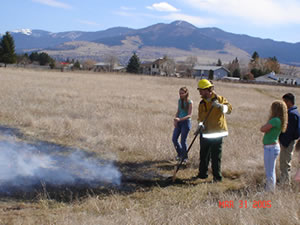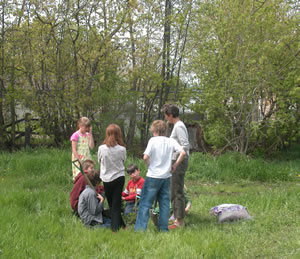|
|
2004-2005 Demonstration Projects
|
|
|
School
|
Project summary
|
|
Big Sky demonstration project
(pdf format) |
The demonstration project for Big
Sky High School was fired up on March 31st. The purpose of their demo project is to introduce students to the scientific method in a hands-on manner, using a locally relevant subject - fire. Several plots were burned at varying levels of intensity and temperature sticks were used to determine the heat of the fire. Students sampled soil characteristics, and plant and insect abundance and diversity before and after the burn. ECOS fellows will analyze the data and present it to the students for them to interpret. |
 Burning a plot at Big Sky High School.
Burning a plot at Big Sky High School.
|
Florence Carlton demonstration project
(pdf format) |
Big things have happened at the Florence
Carlton outdoor classroom! This special part of their schoolyard has been designated as an official National Wildlife Federation (NWF) schoolyard habitat. A schoolyard habitat site not only provides inspiration for learning among students, teachers and the community, but will be an important part of the local ecosystem by providing essential habitat for wildlife. Certified schools receive resources, training and curriculum support |
 Florence Carlton's schoolyard is designated as
a National Wildlife Federation Schoolyard Habitat.
Florence Carlton's schoolyard is designated as
a National Wildlife Federation Schoolyard Habitat.
|
Lewis and Clark demonstration project
(pdf format) |
The Lewis and Clark project was two-fold:
Creation of a worm composting system and "science backpacks." Students
choose a worm composting system to reduce lunch wastes
and provide compost for their outdoor classroom; fellows
saw this as a vehicle to teach nutrient cycling. Missoula
has an environment ideal for ecology field trips, hence
the ECOS committee decided to create "science backpacks" to
aid in observing local ecology. We introduced the composting
project to the school and began composting. The worm
bins have been used in classroom investigations. We
anticipate implementation of the composting systems
in the lunch room by early next school year. The "science
backpacks" will be ready to use early next year as
well. |
Lewis and Clark students put
their composting knowledge to work.
|
Sussex demonstration project
(pdf format) |
Sussex School is restoring a
schoolyard area from an exotic
to a native environment while
monitoring the biodiversity and
ecological health before, during,
and after restoration. All grades
from K-8, will participate in
project activities. The ECOS
team and students will conduct
plant, invertebrate, mammal,
bird, reptile, and amphibian
surveys of the schoolyard. These
activities will help students
acquire skills in performing field
research while comparing nonnative
and native environments.
This year’s ECOS team will work
on restoration, begin a butterfly
garden, and build a greenhouse.
In the future, several
educational themes will be
applied to this area, including
native plant restoration,
riparian habitat, and weather
monitoring. |
 Sussex students prepare their schoolyard by planting
bird friendly native plants.
Sussex students prepare their schoolyard by planting
bird friendly native plants.
|
Target Range demonstration project
(pdf format) |
As part of the Target
Range restoration
garden demonstration project we initiated three main
projects within the schoolyard: 1) treated an area of
the schoolyard to reduce and contain noxious weed invasion
2) developed a noxious weed biocontrol monitoring and
sampling program in cooperation with the Missoula County
Weed District 3) restored and revegetated an area within
the schoolyard with native northern Rocky Mountain plants,
to be used as an outdoor ecological teaching laboratory.
As the result of this project, s tudents displayed increased
interest in the fauna and flora within their schoolyard. |
 Target Range students work on their native plant garden.
Target Range students work on their native plant garden.
|
|
| |
|


 Funded by the National Science Foundation
Funded by the National Science Foundation